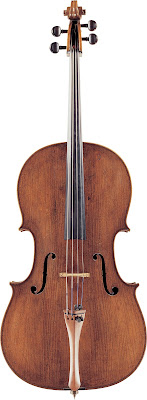The classical Cremona makers produced violin family instruments in a wide range of sizes:
In the 250 years from 1540 to 1790, Classical Italian violin makers produced many examples of the different sized violin family instruments represented here.
1690 Strad 'Medici' representing the typical large form early cellos:
This cello has a body length of approximately 79.25cm. While long by today's standards, this was typical of almost all cellos before 1700.
With time, the cellists themselves showed a strong preference for smaller sized cellos. Beginning in Brescia, and later Venice, makers began to produce smaller cellos to meet player demand. Trailing a few years later, the Cremona maker families of Guarneri, Ruggieri, and eventually Stradivari followed with smaller model cellos.
1697 Andrea Guarneri cello:
This small form cello has a body length of about 74.5cm. Using a regional measurement of the time, that is about 1 oncia shorter than the early longer cellos.
In later generations, the shorter cellos were so much more popular with players that almost all of the older long form cellos were cut down and reduced to smaller sizes. An original uncut long form cello, like the 1690 'Medici' Stradivari cello shown is very rare today.
During the classical Italian period of making, many violas were made of varying sizes. The largest 'Tenor' violas are today not in common use. As with the cellos, earlier generations of makers and players appreciated the tonal advantages of the very large instruments, but with time a great preference emerged for the greater agility offered by smaller instruments.
As with cellos, the older large size violas tended to eventually get chopped down to a smaller size. Not many of the old 'tenor violas' survive in their uncut original size.
An uncut 1644 tenor viola by Andrea Guarneri:
This uncut tenor viola has a body length of approximately 48.3cm. Which by today's standards would be considered unplayable by most violists.
Besides the large tenor violas, the classical Italians also made smaller 'contralto violas'.
The 1696 contralto viola 'Archinto' by Stradivari:
This viola has a very playable body length of 41.4cm.
Today, the standard expectations for violin size have become very specific. We would tend to see a violin body length of 35.1cm as a little too small, and we would likely see a body of 35.9cm as biggish.
This very narrow window for 'standard' size emerged later. We see the classical Italian makers producing violins in a wider variety of sizes. The Brescian makers often made violins over 36cm, even approaching 37cm at times. And throughout the period of classical Italian making, makers produced alternate 'small' violin models with body sizes averaging around 34.5cm.
1671 violin by Nicolo Amati:
This violin has a body length of approximately 35.3cm.
A 'small violin' by Andrea Amati, ca 1570:
This small violin has a body length of approximately 34.3cm, making it shorter than normal violins by only about the width of a finger.
Throughout the classical period, we also see makers producing significantly shorter 'piccolo' violins. We don't know for sure, but likely these were tuned to a higher pitch than standard violins. While a few scores from the time (Bach's Brandenburg #1) show us these were part of Baroque musical life, piccolo violins have long fallen out of use.
1613 Brothers Amati 'piccolo' violin:
This piccolo violin has a body length of approximately 27cm.
These seven sizes; large and small cellos, tenor and contralto violas, large and small violins, and piccolo violins, represent the basic size categories of the classical Italian maker's violin family.
Besides violin family instruments, these classical makers sometimes produced other kinds of bow and plucked string instrument, as well as strings, cases, bows, and various accessories.
Occasionally, they also made children's sized variants on the violin family, and various kinds of 'dancing master' violins meant to be conveniently portable.
1717 pochette by Stradivari:
This violin has a very short body of about 32.3cm, but is so arrange as to have its string length close to normal.
'Chardon' 1735 dancing master violin by Guarneri Del Gesu:
This instrument has a very short body length of only about 23.9cm.
I've left the double bass for last, as it has its own complicated and rather independent history. The bass blends features of the violin family with features form the viol family. Classical Italian makers produced many basses, particularly in Brescia and Venice.
ca 1680, bass by Hieronymus II Amati:
Body length approximately 111.7cm.
Were can I see these and other classical Italian instruments on the web?













No comments:
Post a Comment